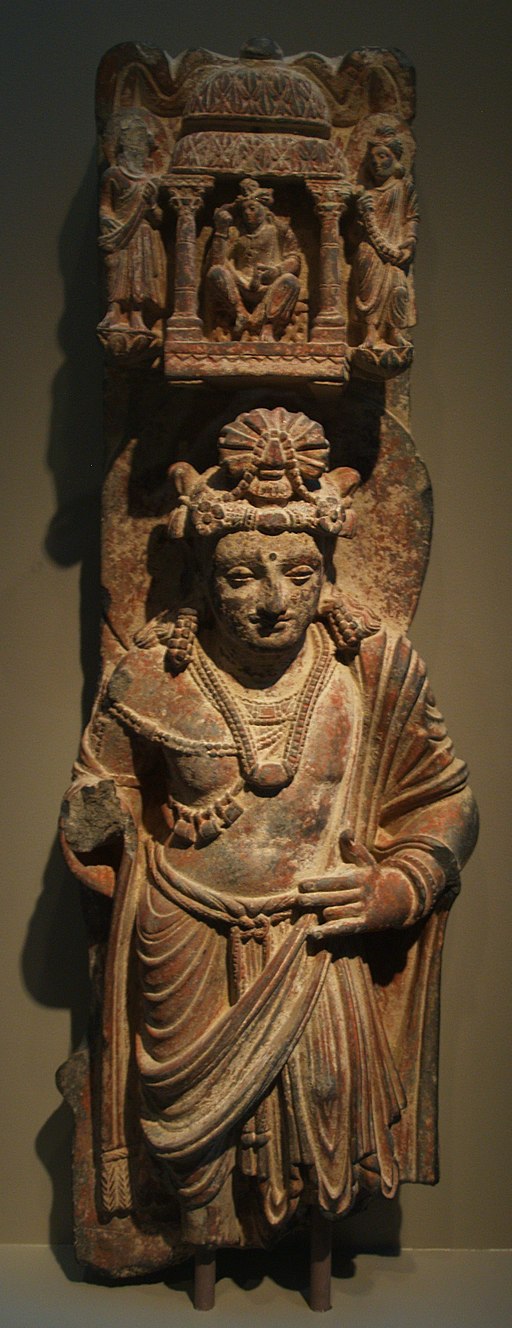
This Gandharan styled statue of Bodhisattva Maitreya depicts as a princely figure with elaborate ornaments. The Maitreya wears a fancy turban, even though a Buddha would invariably wear a simple monk’s robe.
A Maitreya is regarded as a future Buddha of this world, as described in Buddhist theology, concerned with death, judgment, and the final destiny of the soul and humankind.
According to Buddhist tradition, Maitreya is a bodhisattva who will appear on Earth in the future, achieve complete enlightenment, and teach the pure dharma.
According to scriptures, Maitreya will be a successor to the present Buddha, Gautama Buddha.
The prophecy of the arrival of Maitreya refers to a future time when the dharma is forgotten by most of the earthly world.
In Buddhist art, a bodhisattva is often depicted as a handsome youthful prince with a serene expression and graceful manner.
This sereneness is in accordance with the description of Prince Siddhārtha Gautama as a bodhisattva.
The depiction of the bodhisattva in Buddhist art aspires to express the bodhisattva’s qualities of:
- loving-kindness (metta)
- compassion (karuna)
- empathetic joy (mudita)
- equanimity (upekkha)
Gender variant representations of some bodhisattvas are due to their ability to manifest in masculine and feminine forms of various degrees.
Bodhisattva
In Buddhism, a bodhisattva is any person who is on the path towards Buddhahood.
In simplified terms, Bodhisattva is described simply as a “Buddhist saint” or those who entered the bodhisattva’s path.
The elaborate concept refers to a sentient being that develops enlightenment possessing the bodhisattva’s psyche.
Gautama Buddha
Gautama Buddha (c. 563/480 – c. 483/400 BCE), also known as Siddhārtha Gautama or simply the Buddha, was a monk, mendicant, sage, philosopher, and teacher on whose teachings Buddhism was founded.
He lived and taught mostly in the northeastern part of ancient India sometime between the 6th and 4th centuries BCE.
Buddha taught a Middle Way between sensual indulgence and the severe asceticism, and he is the primary figure in Buddhism.
He is believed by Buddhists to be an enlightened teacher who attained full Buddhahood and shared his insights to help sentient beings end rebirth and suffering.
Bodhisattva Maitreya
- Title: Bodhisattva Maitreya
- Material: phyllite with traces of pigment and gold
- Created: 2nd-3rd century
- Dimensions: H x W x D: 74.3 x 26 x 13.3 cm (29 1/4 x 10 1/4 x 5 1/4 in)
- Created: Pakistan or Afghanistan
- Type: Buddhist Sculpture
- Museum: Arthur M. Sackler Gallery
Korean pensive bodhisattva
Maitreya Buddha
A Tour of Washington, D.C. Museums
- National Gallery of Art
- National Museum of American History
- National Air and Space Museum
- National Museum of African American History and Culture
- National Museum of Natural History
- National Portrait Gallery
- Smithsonian American Art Museum
- The Phillips Collection
- Hirshhorn Museum and Sculpture Garden
- International Spy Museum
- National Museum of Women in the Arts
- United States Holocaust Memorial Museum
- Freer Gallery of Art
- Arthur M. Sackler Gallery
Bodhisattva
~~~
“There is no fear for one whose mind is not filled with desires.”
– Buddha
~~~
Photo Credit: 1) Miguel Hermoso Cuesta / CC BY-SA (creativecommons.org/licenses/by-sa/4.0)
Popular this Week








 Sponsor your Favorite Page
Sponsor your Favorite Page SEARCH Search for: Search Follow UsJoin – The JOM Membership Program
Sponsor a Masterpiece with YOUR NAME CHOICE for $5
Share this:
- Tweet
